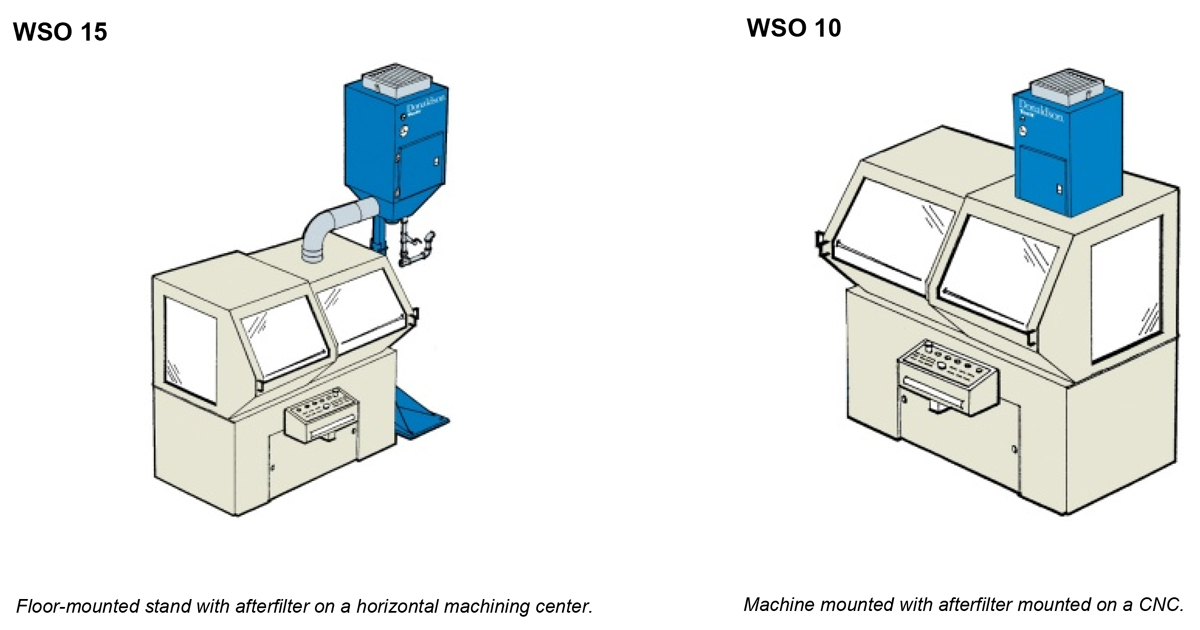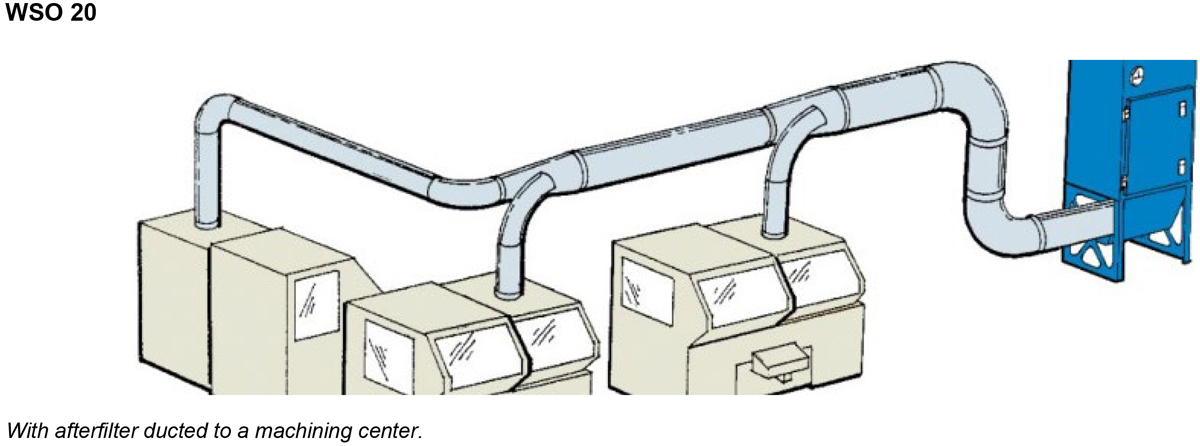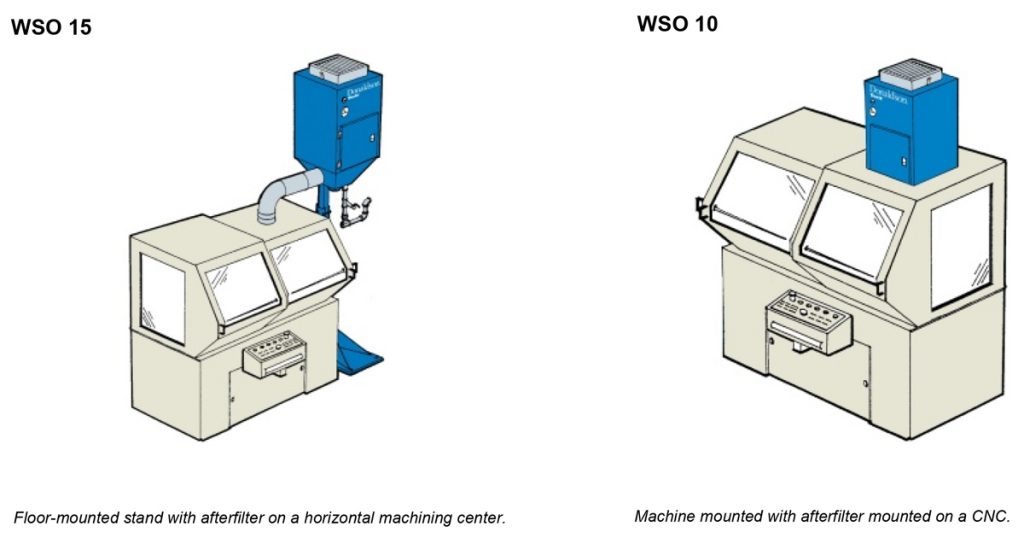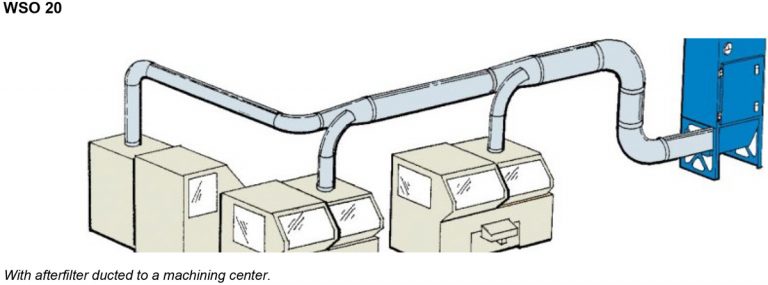Choosing a Mist Collection System
Mist collection is a vital component of in-plant air quality control and overall plant maintenance. The absence of or the poor quality of mist filtration could leave harmful fumes and mist in the plant that could be detrimental to plant occupational safety.
Minimizing Equipment Maintenance
Proper mist control is also important in minimizing maintenance costs throughout the plant by preventing possible damage to air conditioning systems, electrical components and interior plant surfaces.
4 Considerations When Choosing a Mist Collection System
When selecting a mist collection system you should consider several factors to determine which system is best suited for your facility. These factors often include:
- physical plant layout
- equipment utilization
- energy consumption
- capital constraints
3 Strategies for Mist Collection
There are generally three strategies for mist collection:
- Single machine per source (mounted or ducted),
- Cellular with a collector serving a few machines, or
- Centralized mist collector serving most sources in an area.
Mist Collection Strategies
The advantages and disadvantages of each strategy are discussed below to help you choose the strategy that best meets your plant’s objectives. Donaldson has several mist collectors available. Contact us about specific needs.
Strategy #1: Single Machine Collection
The first strategy involves a single machine connected to a dedicated mist collector. This approach is the most commonly used because it allows flexibility in how the mist collector is mounted. A mist collector can be mounted directly to the machining center (eliminating the need for a connecting duct) or in close proximity to the machine center (connecting it with a short amount of duct.) The mounting variety offers solutions to plant challenges like head and floor space issues, process flow considerations (such as cranes), equipment relocations or plant expansions.

Advantages
The main advantage to a single machine strategy is it allows the mist collector to match the application. There are many technologies available for mist collection, and each application determines which technology will best fit your requirements. A single machine strategy often ensures longer filter life by optimizing the filtration technology used on a given application.
Another advantage is flexibility with a plant production schedule; you only power up the machines needed at a given time. Finally, maintenance flexibility is a key advantage to this strategy. Downtime maintenance, and oil/coolant or mist filter change-outs are timed with production schedules. Maintenance is reduced for coolant reservoirs since cross contamination is prevented, and mist collected in the filter drains back to the machines coolant reservoir.
Disadvantages
The dedicated source collection strategy does have potential disadvantages as well. Individual machines require separate motor starters, which may increase installation costs if multiple machines are involved. You may pay a higher price for multiple individual mist collectors compared to any economy of scale for a central or cellular type strategy. From a maintenance standpoint, you potentially have more filters to maintain and dispose of over a central or cellular system. These potential costs need to be evaluated against the advantages when considering this mist collection strategy.
Strategy #2: Cellular Collection
The cellular mist collection strategy typically consists of 3-5 machining centers served by a single mist collector. Often the machines perform sequential work on the same part, and all the machines use a common coolant system. With a cellular strategy, if one machine center is down, the whole cell is usually down, therefore, this process lends itself well to a single mist collector handling all machines in the cell.

Advantages
The main advantage to this strategy is maintenance, which is easily scheduled during downtime of the manufacturing cell. Since there are fewer mist collectors, you have fewer total filters to purchase, maintain, or dispose of. A common coolant allows you to return coolant to your plant’s coolant filtration system without cross contamination.
Another advantage to a cellular mist collection strategy is lower start up cost. The economy of scale with a larger mist collector may lower cost compared to multiple individual mist collectors. Installation costs are often lower because you are rigging and wiring one unit versus multiple units, and operating costs may drop as you replace fewer filters. Energy consumption is also lower by using only one collector.
Disadvantages
The cellular mist collection strategy poses some challenges. Ducting a variety of applications into a single mist collector may mix coolants, which may be detrimental to filter life. If just one of the processes presents a challenge for a specific mist collection technology, you may experience shorter filter life for the entire system. When considering this strategy, discuss your machining processes with your mist collector manufacturer. These experts have knowledge regarding which collector technologies may be best suited for each situation and may be able to help you avoid costly mistakes.
A second challenge for the cellular strategy is duct design and installation. You must consider proper design criteria to ensure sufficient conveying velocities in the ducts, so mist does not settle and create potential leaks. (A 1° – 3°degree slope angling back to the machine is good.) Any leakage in the duct is likely to find its way to the plant floor or equipment, creating hazards for workers or damaging equipment. To minimize oil leakage, consider outside expertise in designing and balancing duct systems to ensure the duct is installed properly.
Other Considerations
Finally, air permitting may be required if airflow exceeds certain limits. Consult your local authorities to make sure you comply with local and federal permitting guidelines before purchasing this type of strategy.
Strategy #3: Central Mist Collection
Centralized mist collection, popular 15-20 years ago, is not as common today primarily due to new machining processes and cutting fluids. This strategy typically handles up to 20 machine centers.
Advantages
If you have a large manufacturing facility with many machine centers, a central mist collection strategy may offer a capital cost advantage on both initial equipment and on electrical installation. Similar to a cellular strategy, you reduce the number of collectors, fans and motors starters so this strategy will typically be less expensive.
A second advantage to a central system strategy turns out to be a disadvantage to plant operations. This strategy makes it extremely easy to schedule maintenance since there is only one unit. However, when that one unit has a problem that is unscheduled, the entire plant is down. Downtime sensitivity may outweigh any other advantage offered by this approach.
Disadvantages
Some disadvantages often make this the least attractive strategy. A central strategy is the largest of the three strategies and takes up a great deal of floor space. It requires careful consideration on location for the collector. Duct design, installation and balancing are complex and challenging, and the increased amount of duct requires fans with higher static pressure and larger individual motor horsepower. This often means operating costs are higher due to increased energy consumption. Similar to a cellular strategy, different machining processes risk shorter filter life if a particular process is not compatible with the mist collector technology selected.
Other Considerations
Note that some initial cost savings are potentially lost by measures such as silencing equipment to handle higher noise levels from larger fans and motors. Additionally, cross contamination of coolants may increase disposal costs of coolants (considered a hazardous waste). Finally, like the cellular strategy, if the air volume exceeds regulatory limits, a permit may be required in order to operate.
Wrapping It Up
These three mist collection strategies all have pros and cons, and deciding which to choose is the first step to a successful system. No matter which strategy you select, a number of different mist collector technologies may meet your facility’s needs. Consult the manufacturer about its mist collection technologies and the benefits of each. A thorough understanding of these technologies is essential to achieving the best solution to your mist control problems.
CHOOSING A MIST COLLECTION SYSTEM
Mist collection is a vital component of in-plant air quality control and overall plant maintenance. The absence of or the poor quality of mist filtration could leave harmful fumes and mist in the plant that could be detrimental to plant occupational safety.
MINIMIZING EQUIPMENT
Proper mist control is also important in minimizing maintenance costs throughout the plant by preventing possible damage to air conditioning systems, electrical components and interior plant surfaces.
4 CONSIDERATIONS WHEN CHOOSING A MIST COLLECTION SYSTEM
When selecting a mist collection system you should consider several factors to determine which system is best suited for your facility. These factors often include:
- physical plant layout
- equipment utilization
- energy consumption
- capital constraints
3 STRATEGIES FOR MIST COLLECTION
There are generally three strategies for mist collection:
- Single machine per source (mounted or ducted)
- Cellular with a collector serving a few machines
- Centralized mist collector serving most sources in an area
MIST COLLECTION STRATEGIES
The advantages and disadvantages of each strategy are discussed below to help you choose the strategy that best meets your plant’s objectives. Donaldson has several mist collectors available. Contact us regarding specific needs.
STRATEGY #1: SINGLE MACHINE COLLECTION
The first strategy involves a single machine connected to a dedicated mist collector. This approach is the most commonly used because it allows flexibility in how the mist collector is mounted. A mist collector can be mounted directly to the machining centre (eliminating the need for a connecting duct)
or in close proximity to the machine centre (connecting it with a short amount of duct). The mounting variety offers solutions to plant challenges like head and floor space issues, process flow considerations (such as cranes), equipment relocations or plant expansions.

ADVANTAGES
The main advantage to a single machine strategy is it allows the mist collector to match the application. There are many technologies available for mist collection, and each application determines which technology will best fit your requirements. A single machine strategy often ensures longer filter life by optimizing the filtration technology used on a given application.
Another advantage is flexibility with a plant production schedule; you only power up the machines needed at a given time. Finally, maintenance flexibility is a key advantage to this strategy. Downtime maintenance, and oil/coolant or mist filter change-outs are timed with production schedules. Maintenance is reduced for coolant reservoirs since cross contamination is prevented, and mist collected in the filter drains back to the machine’s coolant reservoir.
DISADVANTAGES
The dedicated source collection strategy does have potential disadvantages as well. Individual machines require separate motor starters, which may increase installation costs if multiple machines are involved. You may pay a higher price for multiple individual mist collectors compared to any economy of scale for a central or cellular type strategy. From a maintenance standpoint, you potentially have more filters to maintain and dispose of over a central or cellular system. These potential costs need to be evaluated against the advantages when considering this mist collection strategy.
STRATEGY #2: CELLULAR COLLECTION
The cellular mist collection strategy typically consists of 3-5 machining centres served by a single mist collector. Often the machines perform sequential work on the same part, and all the machines use a common coolant system. With a cellular strategy, if one machine centre is down, the whole cell is usually down. Therefore, this process lends itself well to a single mist collector handling all machines in the cell.

ADVANTAGES
The main advantage to this strategy is maintenance, which is easily scheduled during downtime of the manufacturing cell. Since there are fewer mist collectors, you have fewer total filters to purchase, maintain or dispose of. A common coolant allows you to return coolant to your plant’s coolant filtration system without cross contamination.
Another advantage to a cellular mist collection strategy is lower startup cost. The economy of scale with a larger mist collector may lower cost compared to multiple individual mist collectors. Installation costs are often lower because you are rigging and wiring one unit versus multiple units, and operating costs may drop as you replace fewer filters. Energy consumption is also lower by using only one collector.
DISADVANTAGES
The cellular mist collection strategy poses some challenges. Ducting a variety of applications into a single mist collector may mix coolants, which may be detrimental to filter life. If just one of the processes presents a challenge for a specific mist collection technology, you may experience shorter filter life for the entire system. When considering this strategy, discuss your machining processes with your mist collector manufacturer. These experts have knowledge regarding which collector technologies may be best suited for each situation and may be able to help you avoid costly mistakes.
A second challenge for the cellular strategy is duct design and installation. You must consider proper design criteria to ensure sufficient conveying velocities in the ducts, so mist does not settle and create potential leaks. (A 1°–3°
degree slope angling back to the machine is good.) Any leakage in the duct is likely to find its way to the plant floor or equipment, creating hazards for workers or damaging equipment. To minimize oil leakage, consider outside expertise in designing and balancing duct systems to ensure the duct is installed properly.
OTHER CONSIDERATIONS
Finally, air permitting may be required if airflow exceeds certain limits. Consult your local authorities to make sure you comply with local and federal permitting guidelines before purchasing this type of strategy.
STRATEGY #3: CENTRALIZED COLLECTION
Centralized mist collection, popular 15-20 years ago, is not as common today primarily due to new machining processes and cutting fluids. This strategy typically handles up to 20 machine centres.
ADVANTAGES
If you have a large manufacturing facility with many machine centres, a central mist collection strategy may offer a capital cost advantage on both initial equipment and on electrical installation. Similar to a cellular strategy, you reduce the number of collectors, fans and motor starters, so this strategy will typically be less expensive.
A second advantage to a central system strategy turns out to be a disadvantage to plant operations. This strategy makes it extremely easy to schedule maintenance since there is only one unit. However, when that one unit has a problem that is unscheduled, the entire plant is down. Downtime sensitivity may outweigh any other advantage offered by this approach.
DISADVANTAGES
Some disadvantages often make this the least attractive strategy. A central strategy is the largest of the three strategies and takes up a great deal of floor space. It requires careful consideration on location for the collector. Duct design, installation and balancing are complex and challenging, and the increased amount of duct requires fans with higher static pressure and larger individual motor horsepower. This often means operating costs are higher due to increased energy consumption. Similar to a cellular strategy, different machining processes risk shorter filter life if a particular process is not compatible with the mist collector technology selected.
OTHER CONSIDERATIONS
Note that some initial cost savings are potentially lost by measures such as silencing equipment to handle higher noise levels from larger fans and motors. Additionally, cross contamination of coolants may increase disposal costs of coolants (considered a hazardous waste). Finally, like the cellular strategy, if the air volume exceeds regulatory limits, a permit may be required in order to operate.
WRAPPING IT UP
These three mist collection strategies all have pros and cons, and deciding which to choose is the first step to a successful system. No matter which strategy you select, a number of different mist collector technologies may meet your facility’s needs. Consult the manufacturer about its mist collection technologies and the benefits of each. A thorough understanding of these technologies is essential to achieving the best solution to your mist control problems.
